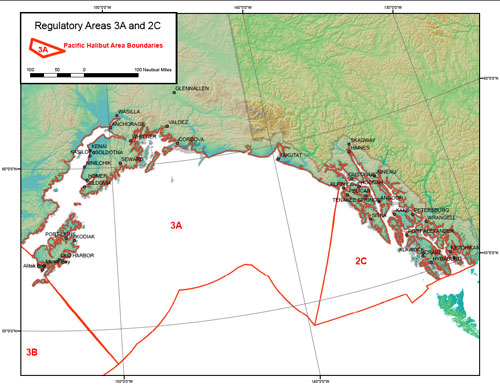
NOAA to implement halibut catch sharing plan in 2014
December 09, 2013
Quoting a NOAA news release, prior to the catch sharing plan, the charter sector was managed under a guideline harvest level - a management program that was not optimal in preventing fishing overages when harvest of halibut by recreational anglers on charter vessels increased in areas 2C and 3A beginning in the late 1990s. The North Pacific Fishery Management Council recommended the catch sharing plan to replace the guideline harvest level with a clear allocation between the commercial and charter sectors in areas 2C and 3A. The Council urged NOAA Fisheries to implement the halibut catch sharing plan in time for the 2014 fishing season. IPHC Areas 2C and 3A. Click for larger version.
Under the catch sharing plan, commercial and charter halibut operations will have a combined catch limit determined by the International Pacific Halibut Commission each year prior to the fishing season. The plan is designed to provide halibut fishery managers with greater precision in setting halibut catch limits and management measures that are responsive to changes in halibut exploitable biomass and fishing effort. Allocations to the charter and commercial sectors will vary with changes in halibut abundance. The catch sharing plan also aims to provide stability and flexibility in charter harvest. One element of the plan that allows for flexibility is the “guided angler fish” program, which authorizes annual transfers of commercial halibut individual fishing quota to charter halibut permit holders to give charter anglers the opportunity to land halibut up to the limit in place for unguided anglers. For example, if unguided anglers were allowed to retain two halibut of any size per person per day, and charter anglers were limited to one halibut of a specific size per person per day, charter halibut operators could use the guided angler fish program to permit a client to harvest up to two fish of any size per day. A copy of the final halibut catch sharing plan is available online at the NOAA Fisheries Alaska Region website: http://alaskafisheries.noaa.gov/
Source of News:
E-mail your news &
photos to editor@sitnews.us
|
||
